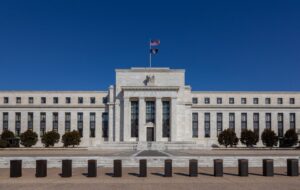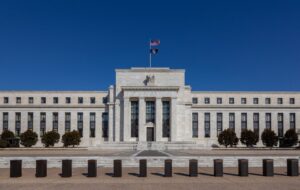
Federal Reserve officials are concerned they may soon find themselves in a tight spot. They have been tasked with delivering price stability and maximum employment — and worry they will not be able to deliver on both given President Trump’s new tariffs.
“It is far from certain, but it is entirely possible that the [Federal Open Market] Committee will be facing both upward pressures on prices and rising unemployment,” Philadelphia Fed President Patrick Harker said last month. “Once there is a trade-off between our mandates, the direction of travel is in question. That is quite different from, say, the last tightening cycle.”
Chicago Fed President Austan Goolsbee recently expressed the same concern. “That’s not an easy situation for the Fed to be in,” he said, “because […] both sides of the mandate get worse at the same time.” Goolsbee confessed that it is unclear what the Fed would do if it faced a tradeoff between its price stability and employment goals: “there’s not an automatic playbook,” he said.
Fed governors have noted the potential tradeoff, as well. Governor Lisa Cook believes “the response of financial markets, firms, and consumers” to President Trump’s trade policy “suggest risks to both sides of our dual mandate.” Likewise, Governor Adriana Kugler sees “greater upside risks to inflation at this juncture and potential downside risks to employment and output growth down the road.”
Indeed, the latest Summary of Economic Projections suggests the concern is widespread among Fed officials. The median FOMC member projected a sluggish 1.4 percent real GDP growth in 2025, with the unemployment rate rising to 4.5 percent. As for inflation, the median member now projects 3.0 percent growth in the Personal Consumption Expenditures Price Index.
At the post-meeting press conference on June 18, Fed Chair Jerome Powell said the FOMC’s “obligation is to keep longer-term inflation expectations well anchored and to prevent a one-time increase in the price level” associated with the tariffs “from becoming an ongoing inflation problem.” However, he also warned about the potential tradeoff:
As we act to meet that obligation, we will balance our maximum employment and price stability mandates, keeping in mind that without price stability we cannot achieve the long periods of strong labor market conditions that benefit all Americans. We may find ourselves in the challenging scenario in which our dual mandate goals are in tension. If that were to occur, we would consider how far the economy is from each goal and the potentially different time horizons over which those respective gaps would be anticipated to close.
Powell said the FOMC was “well positioned to wait — to learn more about the likely course of the economy before considering any adjustments to our policy stance.”
In other words, Fed officials worry they will not be able to deliver both price stability and maximum employment; they will need to choose between the two. And, since the new tariffs will tend to push inflation up and employment down, they fear improving on one side of the mandate might come at a steep cost in terms of the other.
The Dual Mandate
Despite all of the concern expressed by Fed officials, the supposed tradeoff between delivering price stability and maximum employment is easily dealt with. Fed officials need only adopt a sensible interpretation of the dual mandate.
The Federal Reserve Act requires the Fed to conduct monetary policy “so as to promote effectively the goals of maximum employment, stable prices, and moderate long-term interest rates.” Despite listing three distinct goals, this directive from Congress is commonly known as the Fed’s dual mandate: it is generally accepted — and attested in Fed documents — that achieving maximum employment and stable prices “creates the conditions needed for interest rates to settle at moderate levels.”
Just as the first two objectives are generally thought to be consistent with the third, there is a sensible interpretation of “maximum employment” and “price stability” that renders the first two objectives wholly compatible, as well. That this interpretation is also consistent with standard macroeconomic theory is better still, since adopting such an interpretation would not saddle the Fed with an obligation to do what cannot be done.
Economists typically make a distinction between the prevailing rate of unemployment and the natural rate of unemployment. The prevailing rate of unemployment denotes whatever unemployment rate happens to be realized at a particular point in time. The natural rate of unemployment denotes the unemployment rate that would be realized if no one were fooled into over- or underproducing. It is the best unemployment rate one can hope for given people’s preferences and abilities to produce goods and services.
When prices rise faster than people expect, they might be fooled into producing more goods and services than they would if they understood what the dollars they are receiving will actually be worth in the months ahead. Correspondingly, this misinformed overproduction will tend to push the unemployment rate below the natural rate of unemployment. Likewise, when prices rise slower than people expect, they might be fooled into underproducing, with unemployment rising above the natural rate.
Ideally, Fed officials will anchor expectations and then conduct monetary policy to meet those expectations. If the public expects 2 percent inflation and the Fed delivers 2 percent inflation, no one will be fooled into over- or under-producing and the unemployment rate will coincide with the natural rate. Economists call this the divine coincidence, and it implies there is no necessary tradeoff between the price stability and maximum employment mandates.
Given the divine coincidence, there are three ways to achieve macroeconomic stability — that is, to prevent periods of over- or underproduction:
- Target a real (i.e., inflation-adjusted or quantity) variable, like the unemployment rate.
- Target a nominal (i.e., current dollar-denominated) variable, like inflation.
- Target both real and nominal variables, by putting some weight on each.
The Fed’s dual mandate corresponds to the third approach.
While all three approaches achieve macroeconomic stability on paper, they might differ significantly in practice. For example, suppose the Fed conducts monetary policy to ensure the prevailing unemployment rate is always equal to the natural rate of unemployment. We do not observe the natural rate of unemployment. Moreover, since technology grows in fits and starts, there is no reason to think the natural rate of unemployment is stable over time. Targeting the unemployment rate, therefore, is like trying to hit an invisible, moving target.
In contrast, targeting inflation is relatively straightforward. We know what inflation should be: what people expect it to be. And, so long as monetary policy is credible, the Fed can anchor inflation expectations on its inflation target rate. If it does so, people will not be fooled into over- or under-producing. The Fed will achieve macroeconomic stability, and the prevailing unemployment rate will be equal to the natural unemployment rate.
To be clear, the argument for targeting a nominal variable exclusively is not an argument that the Fed should not care about real variables. Rather, it is to acknowledge the difficulty of targeting real variables directly. In practice, the most effective way to ensure that real variables are close to their respective natural rates is to target a nominal variable exclusively. That may seem counterintuitive. But that’s what the divine coincidence implies.
What’s the Harm with the Dual Mandate?
If Fed officials can best achieve their dual mandate by focusing exclusively on the price stability portion, what harm is there in including the employment portion as well? In brief: it can only make policy worse, not better.
If Fed officials focus exclusively on the price stability portion of the dual mandate, the employment portion will do no harm. But there is little reason to think Fed officials will focus exclusively on the price stability portion, especially considering they know they will be called to account for the employment portion as well. Fed officials may be tempted to “improve upon” the natural rate of unemployment — that is, they may reduce the prevailing unemployment rate below the natural rate of unemployment by fooling people into taking jobs those people would not take if those people understood how fast the dollar was depreciating. Even if they can avoid that temptation, they risk miscalculating the natural rate of unemployment. If they split the difference when their properly calibrated inflation target and improperly calibrated unemployment target require different adjustments to monetary policy, monetary policy will be worse than if they had focused exclusively on price stability.
The risk that including the employment portion of the dual mandate will make monetary policy worse is not hypothetical. Consider recent statements from Fed officials. They generally understand that they should look through any price effects of a tariff, since those price effects are supply-driven and, hence, outside the control of the Fed. But they are inclined to interpret any upward movement in the unemployment rate as an indication that they are performing worse on the employment portion of their mandate. That interpretation ignores the (very likely) possibility that tariffs will cause the natural rate of unemployment to rise. If the natural rate of unemployment rises, the Fed should target a higher unemployment rate. Again: it is hard to hit an invisible, moving target.
Fed officials could ease their minds by adopting a sensible interpretation of the dual mandate, based on the divine coincidence. With this sensible interpretation in mind, they might go about achieving the dual mandate by focusing exclusively on inflation. Better still, Congress could remove the ambiguity by replacing the error-prone dual mandate with an easy-to-follow single mandate that requires the Fed to deliver price stability. In doing so, Congress would help ensure the unemployment rate remained near the natural rate of unemployment, as well.

